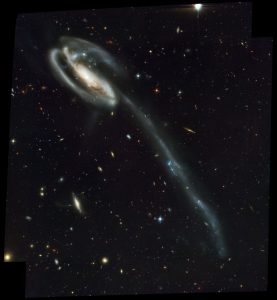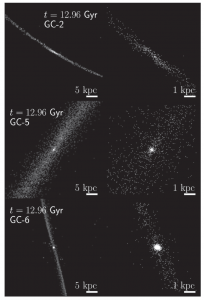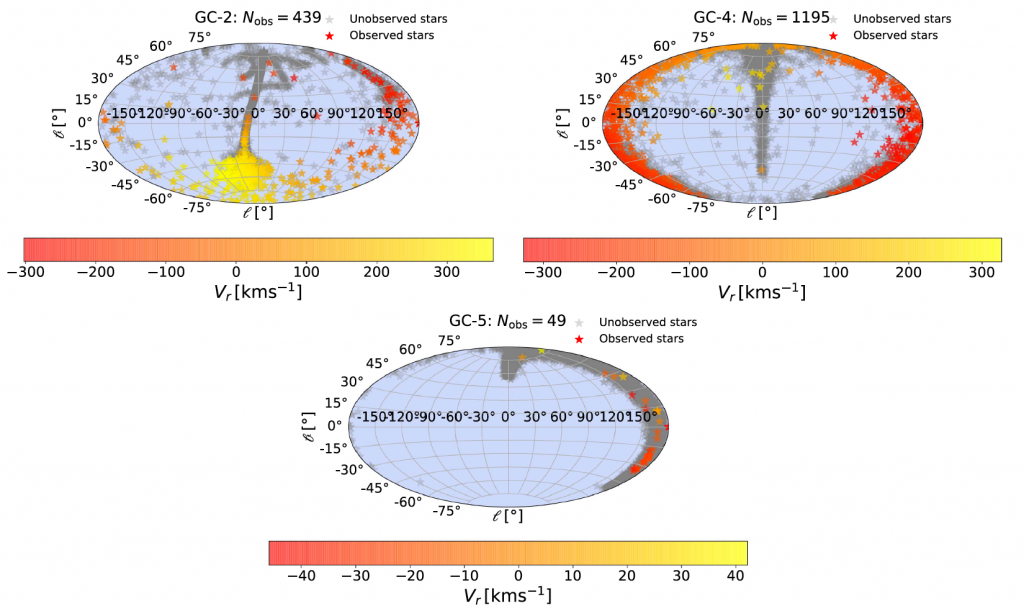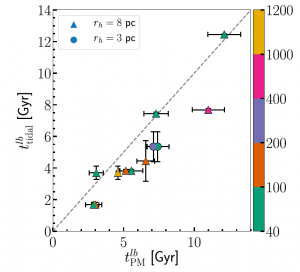Editor’s note: This article, written by AAS Media Fellow Kerry Hensley, was originally published on Astrobites.

Figure 1. Tidal forces don’t only have an effect on globular clusters! The dramatic tail of the Tadpole Galaxy (Arp 188) is also the result of a gravitational tug. [NASA]
As the stars in globular clusters interact gravitationally, some gain enough kinetic energy to be ejected from the cluster entirely. The shrinking of globular clusters through this process is called evaporation. When the ejected stars escape the gravitational confines of the cluster, the gravitational pull of the Milky Way starts to take over. As the cluster orbits the galactic center, it experiences tidal forces. Much like an unwitting spacefarer approaching a black hole, globular clusters get stretched out by these tidal forces, stringing those escaped stars into a tidal tail or stream (see Figure 1).
We see these tidal tails in many globular clusters, but the question remains: How can we figure out when the tidal disruption began?

Figure 2. Simulated globular-cluster tidal streams at a redshift of 0. All else being equal, a more compact cluster (bottom row) experiences less tidal disruption than a more extended cluster (top row). [Bose et al. 2018]
Tracing Tidal Evolution
Today’s paper introduces a new technique to estimate the age of tidally disrupted globular cluster streams. While the ages of the globular clusters themselves are usually determined using stellar evolution models, it can be challenging to figure out when the gravitational pull of the Milky Way began to tear them apart.
The authors of today’s paper found a way to pinpoint the time of tidal disruption by considering the evolution of simulated globular clusters orbiting a Milky-Way-like galaxy. They varied the initial position and velocity (with respect to the center of the Milky Way’s gravitational potential) of six otherwise identical globular clusters — they have the same mass (100,000 solar masses) and initial mass function.
The simulated globular clusters were then allowed to evolve forward in time from roughly 13 billion years ago to today. Figure 2 shows the results of the simulations for three of the six clusters, demonstrating the importance of the initial conditions.
Tidal Disruption in 3… 2… 1…
While the simulated globular clusters give us a good sense of what happens during tidal disruption, they aren’t a good representation of what we would actually observe; telescopes aren’t infinitely sensitive, and their magnitude cutoffs can impose some interesting restrictions on observations. To explore this, the authors simulated what the Gaia survey would see when observing these clusters, assuming a sensitivity limit of 20 magnitudes. Figure 3 compares observable and unobservable stars from three of the simulated clusters.

Figure 3. Maps of the sky in galactic coordinates showing three of the simulated clusters. Stars unobservable by Gaia are shown in grey, while observable stars are shown in color, with the color corresponding to each star’s radial velocity. The number of observable stars decreases as the distance to the cluster increases (counterclockwise from top right). [Bose et al. 2018]

Figure 4. Comparison of the disruption time estimated using the positions and proper motions of stars (horizontal axis) and searching backward through the simulations. The proper motion/position method tends to slightly underestimate the time since tidal disruption. [Bose et al. 2018]
This happens because larger stars are brighter and more easily observed, and tend to be found closer to the center of the cluster. As a result, smaller stars are drawn into the tidal stream before larger stars, and the inferred time since disruption tends to be a bit too short. Still, this is a huge step forward along the path to accurately dating the tidal disruption of globular clusters — an exciting prospect for learning more about the Milky Way’s history!
Citation
“Dating the Tidal Disruption of Globular Clusters with GAIA Data on Their Stellar Streams,” Sownak Bose et al 2018 ApJL 859 L13. doi:10.3847/2041-8213/aac48c
